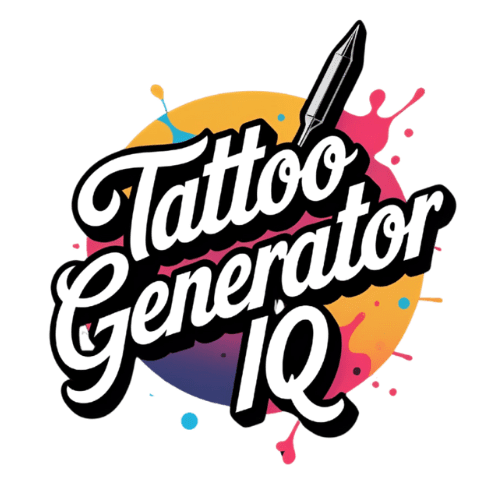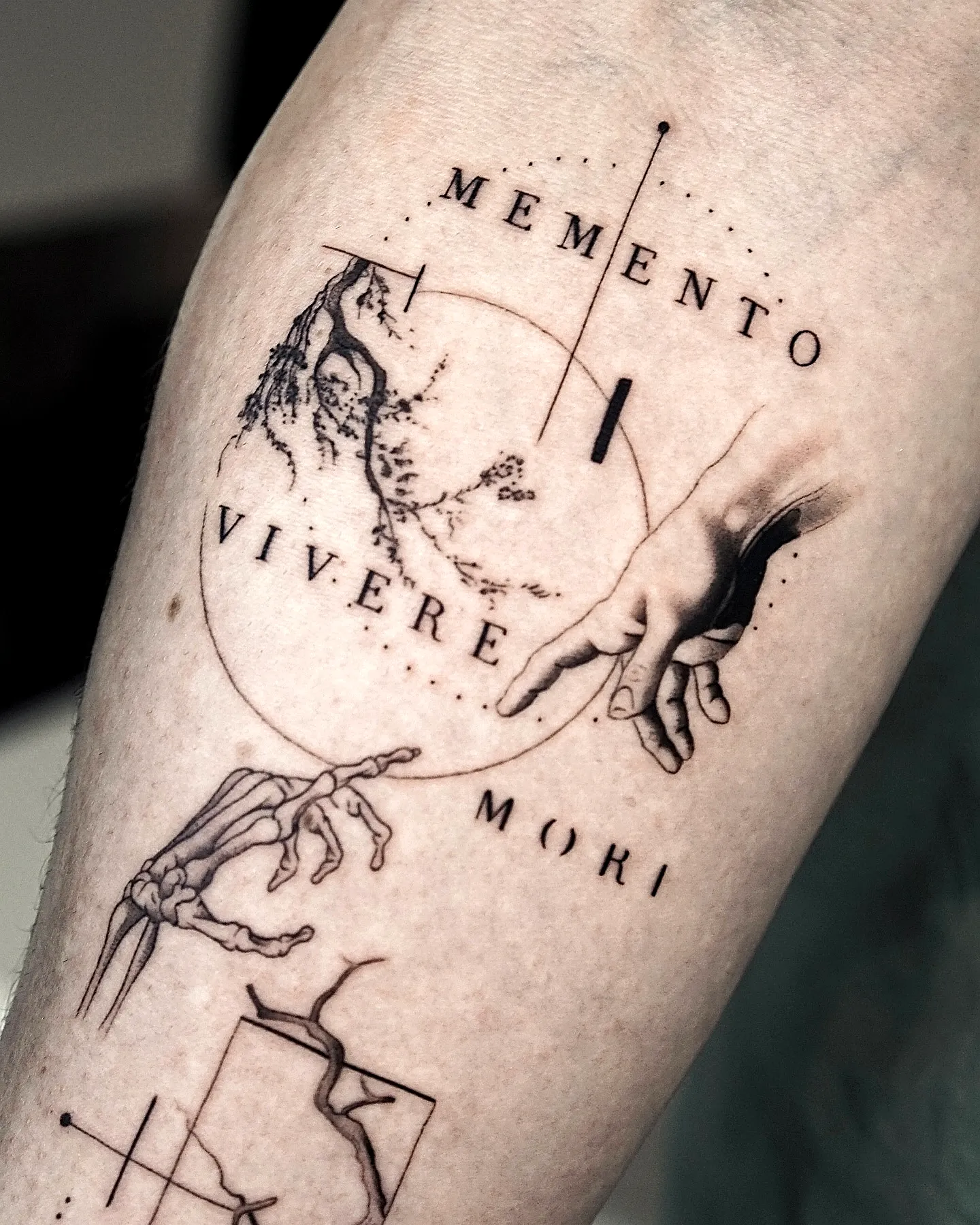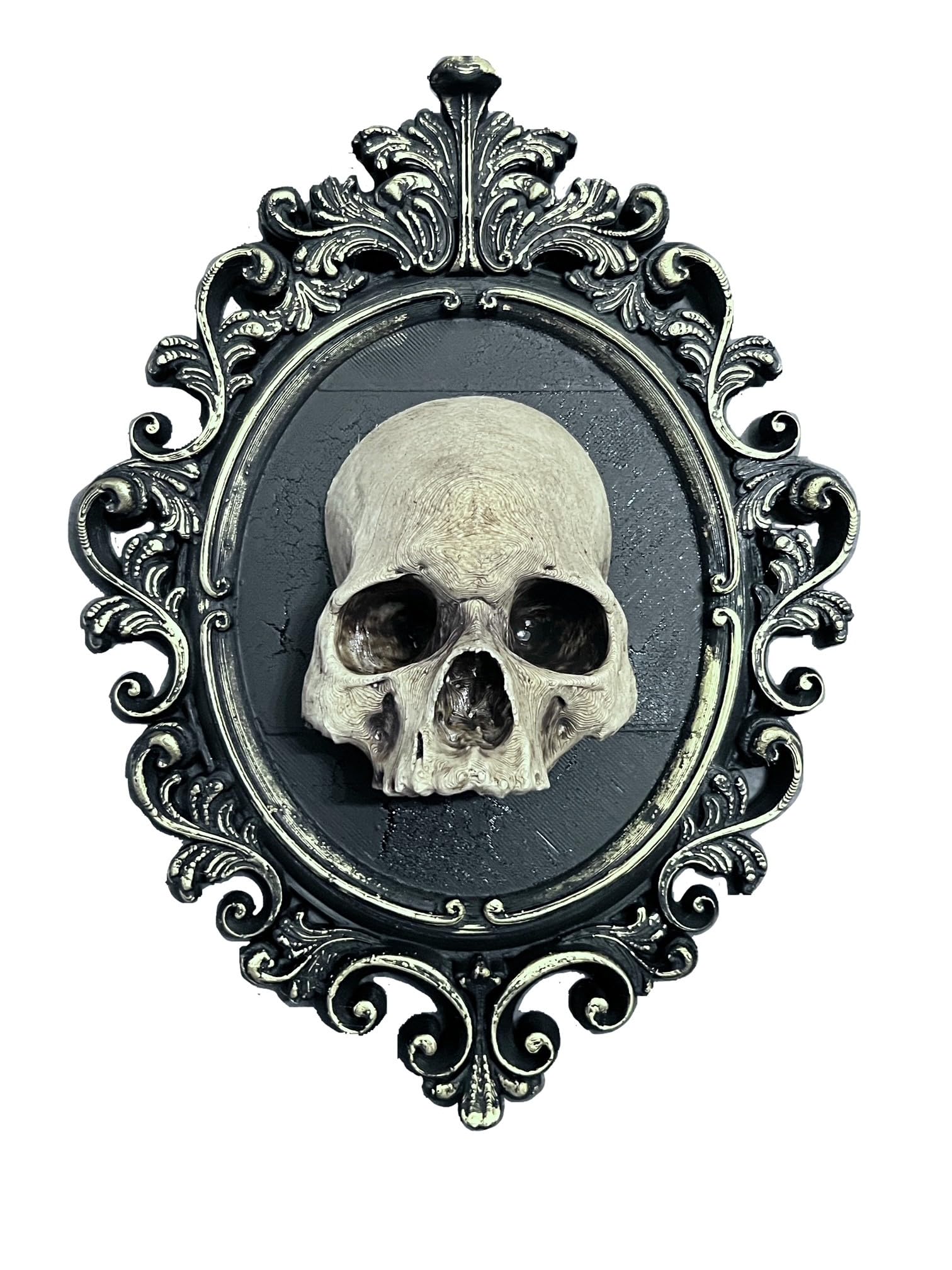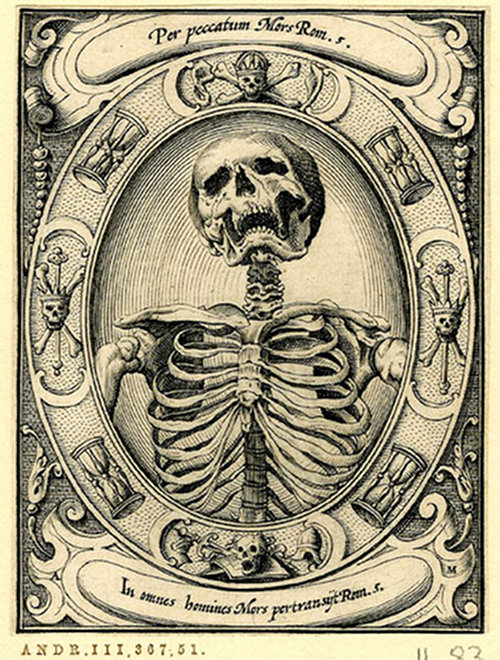25 Memento Mori Tattoo Ideas That’ll Make You Embrace Life’s Precious Moments
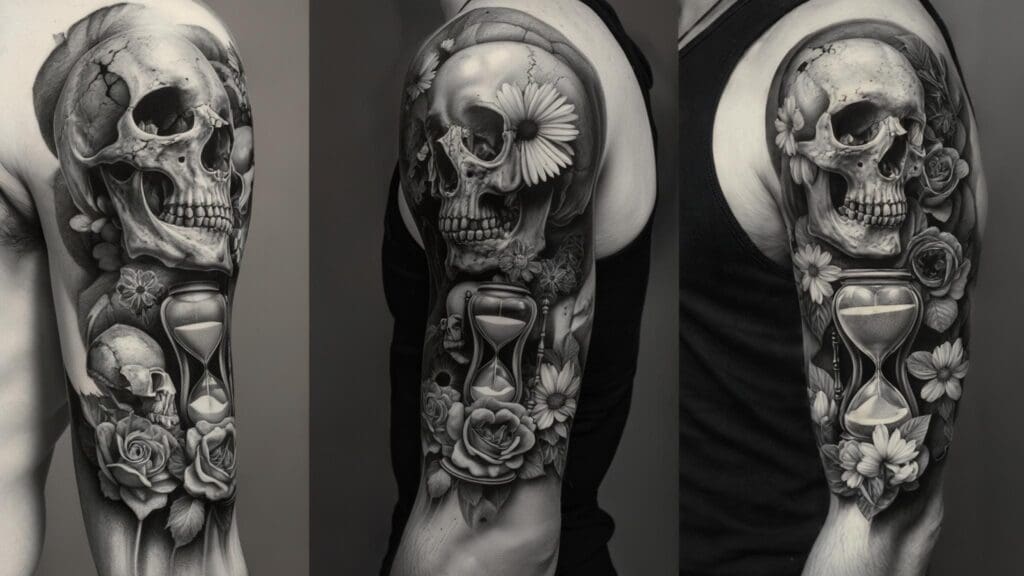
According to VEAN Tattoo, memento mori tattoos aren’t just body art—they’re deep symbols suited for individuals seeking a mindful and introspective life. I remember the first time I encountered this Latin phrase meaning “remember you must die.” Rather than feeling morbid, it struck me as profoundly liberating. The reminder of mortality became a catalyst for living more intentionally, appreciating fleeting moments, and focusing on what truly matters.
These powerful designs serve as daily meditation tools, transforming your body into a canvas of philosophical reflection. Whether you’re drawn to classic skull imagery, time-based symbolism, or modern interpretations, memento mori tattoo designs offer endless possibilities for personal expression while honoring an ancient tradition of mindful living.
Source: jerwoodvisualarts.org
Table of Contents
- Essential Considerations for Your Memento Mori Tattoo Journey
- Classic Skull-Based Designs (Ideas 1-5)
- Time and Mortality Symbols (Ideas 6-10)
- Nature and Decay Motifs (Ideas 11-15)
- Philosophical and Literary Designs (Ideas 16-20)
- Modern Interpretations (Ideas 21-25)
- Placement Strategies That Maximize Impact
- Cultural Context and Historical Significance
- Advanced Customization Techniques
- Professional Execution Guidelines
- How Tattoo Generator IQ Transforms Your Design Process
TL;DR
- Memento mori tattoos serve as powerful reminders to live meaningfully while acknowledging mortality’s reality
- 25 distinct design categories span from traditional skulls to modern geometric interpretations
- Placement strategy significantly affects both visibility and personal impact of your chosen design
- Cultural understanding enriches the symbolic depth and personal meaning of your tattoo
- Professional artist selection requires specific skills in anatomical accuracy and symbolic imagery
- Tattoo Generator IQ streamlines the design exploration process with instant visualization capabilities
Essential Considerations for Your Memento Mori Tattoo Journey
Selecting the perfect memento mori tattoo requires careful evaluation of symbolic meaning, placement strategy, artistic style compatibility, size considerations, and long-term visual impact. These foundational decisions determine how effectively your tattoo serves its philosophical purpose while maintaining aesthetic appeal throughout your lifetime.
Symbolic depth evaluation involves examining how mortality themes resonate with your personal values, life experiences, and philosophical outlook on death’s role in meaningful living. I’ve seen people rush into getting a memento mori tattoo without truly understanding what it means to carry that daily reminder. The weight of mortality symbolism demands honest self-reflection about your relationship with death and how you want that awareness to influence your daily choices.
Placement strategy affects daily visibility for meditation purposes, professional considerations, canvas size for design complexity, and the tattoo’s ability to serve as a constant reminder of life’s fragility. Understanding the pain level tattoo chart can help you make informed decisions about placement, especially when considering larger memento mori tattoo designs that require multiple sessions.
| Decision Factor | Small Design (2-4 inches) | Medium Design (4-8 inches) | Large Design (8+ inches) |
|---|---|---|---|
| Complexity Level | Simple symbols, minimal detail | Moderate detail, 2-3 elements | Intricate compositions, multiple symbols |
| Ideal Placement | Wrist, ankle, behind ear | Forearm, shoulder, upper back | Chest, full sleeve, back piece |
| Time Investment | 1-2 hours | 3-5 hours | 6+ hours (multiple sessions) |
| Budget Range | $150-$400 | $400-$800 | $800-$2000+ |
| Aging Considerations | Bold lines maintain clarity | Moderate detail preservation | May require touch-ups over time |
Symbolic Depth and Personal Meaning
The philosophical weight of memento mori imagery demands deep personal reflection before committing to permanent body art. Your chosen design should authentically represent your relationship with mortality while inspiring daily mindfulness about life’s precious nature.
Personal resonance assessment requires examining your current life stage, spiritual beliefs, loss experiences, and philosophical framework for understanding death’s role in human existence. I’ve worked with clients who chose their memento mori tattoo during major life transitions—after losing a parent, surviving a health scare, or reaching milestone birthdays that made mortality feel more real.
Meaningful symbolism selection involves choosing imagery that maintains relevance across different life phases while providing consistent motivation for intentional living. Consider Sarah, a 28-year-old nurse who chose a small hourglass with wings on her wrist after losing her grandmother. The design serves as a daily reminder during patient care to cherish each moment while honoring her grandmother’s memory. The wings represent her belief in spiritual transcendence, while the hourglass reminds her that time with loved ones is precious and finite.
Placement Strategy Analysis
Different body locations dramatically affect your tattoo’s impact, visibility, and symbolic function. Strategic placement enhances the design’s ability to serve as a daily meditation tool while considering professional requirements and personal comfort levels.
Before deciding on placement, it’s crucial to understand how much tattoos cost as larger, more visible placements often require higher investment due to their complexity and size requirements. Visibility considerations balance personal reflection needs with professional requirements, social acceptance, and the desire for private versus public philosophical statements.
Canvas size requirements determine design complexity possibilities, with larger areas accommodating intricate symbolic combinations while smaller spaces suit minimalist approaches. The memento mori tattoo you choose needs adequate space to breathe and maintain its symbolic power over time.
Source: tattooing101.com
Artistic Style Compatibility
Memento mori designs translate differently across various artistic approaches, from traditional bold lines to contemporary watercolor techniques. Style selection should complement both the symbolic message and your personal aesthetic preferences.
Traditional approaches emphasize bold symbolism with timeless appeal, while realistic styles focus on anatomical accuracy and detailed mortality representations. I’ve noticed that people drawn to traditional memento mori tattoos often appreciate the historical weight and proven longevity of classic tattoo techniques.
Contemporary interpretations blend classical themes with modern techniques, offering fresh perspectives on ancient philosophical concepts through innovative artistic execution. These styles can make mortality themes feel more accessible to people who might find traditional skull imagery too intense or gothic.
Classic Skull-Based Designs (Ideas 1-5)
Traditional skull imagery forms the foundation of memento mori tattoo art, offering direct mortality symbolism through various artistic interpretations. These designs range from simple traditional skulls to elaborate Victorian ornamentations, each providing unique approaches to death meditation and philosophical reflection.
Skull symbolism provides universal mortality recognition across cultures while offering anatomical accuracy opportunities for medical professionals and science enthusiasts. The human skull represents the most direct visual reminder of our physical mortality—there’s no ambiguity in its message.
Design complexity varies from simple traditional outlines suitable for smaller placements to intricate ornamental versions requiring larger canvas areas and skilled artistic execution. When choosing your memento mori skull tattoo, consider how much detail you want in your daily reminder and whether subtle or bold imagery better serves your meditation practice.
Source: pinimg.com
1. Traditional Memento Mori Skull
Classic human skull rendered in traditional tattoo style features bold black lines with minimal shading, often incorporating roses, hourglasses, or Latin phrase scrolls. This timeless design offers direct mortality symbolism with excellent aging characteristics and broad placement flexibility.
Traditional styling ensures longevity through bold line work that maintains clarity over time, while classic imagery provides universal philosophical recognition. I’ve seen these memento mori tattoos age beautifully over decades because the bold approach doesn’t rely on fine details that can blur.
Symbolic additions like roses represent life’s beauty, hourglasses emphasize time’s passage, and Latin scrolls add intellectual depth to the core mortality message. The beauty of this approach lies in its straightforward honesty—no metaphors or hidden meanings, just pure mortality awareness.
2. Ornate Victorian Skull
Elaborately decorated skull featuring intricate Victorian-era ornamentation, filigree patterns, and gothic architectural elements creates sophisticated mortality imagery. This complex design requires larger placement areas but offers exceptional artistic detail and historical depth.
Victorian ornamentation adds historical context from an era obsessed with death rituals, mourning jewelry, and elaborate funeral customs that celebrated mortality’s dignity. The Victorian period understood death as a natural part of life worth honoring through beautiful artistic expression.
Intricate detailing demands skilled artistic execution and larger canvas areas like chest or sleeve placements to properly showcase the elaborate decorative elements. These memento mori tattoos work best when you have space to let the ornamental details shine and create visual impact.
Source: media-amazon.com
3. Skull with Crown and Flowers
This design juxtaposes mortality symbolism with earthly power and natural beauty, creating powerful visual statements about worldly achievements’ temporary nature. The crown represents authority while flowers symbolize life’s fleeting beauty surrounding death’s inevitability.
Symbolic contrast emphasizes how death equalizes all social positions, making earthly power and status ultimately meaningless in mortality’s face. Kings and peasants share the same fate—a humbling reminder that resonates across all social classes.
Floral elements can be customized with personal significance—birth flowers, memorial blooms, or seasonal varieties that add individual meaning to universal themes. Your memento mori tattoos can incorporate flowers that held special meaning for lost loved ones or represent personal growth through mortality awareness.
4. Day of the Dead Sugar Skull
Colorful, decorative skull design inspired by Mexican Día de los Muertos traditions celebrates death as part of life’s natural cycle rather than fearing mortality. This vibrant approach offers positive perspectives on death while maintaining philosophical depth.
Cultural celebration aspects transform morbid imagery into joyful remembrance, honoring deceased loved ones while embracing death as natural life transition. The Mexican approach to death offers a refreshing alternative to Western fear-based mortality perspectives.
Decorative patterns allow extensive personalization through color choices, floral motifs, and symbolic elements that reflect individual heritage or spiritual beliefs. These memento mori tattoos can be as unique as the person wearing them while maintaining cultural authenticity.
Source: pinimg.com
5. Anatomical Skull Study
Medically accurate skull rendering emphasizes the scientific reality of human mortality, appealing particularly to medical professionals or those with scientific interests. This precise approach combines educational value with philosophical reflection on biological existence.
Scientific accuracy requires detailed anatomical knowledge and skilled artistic execution to properly represent bone structure, sutures, and proportional relationships. Healthcare workers often gravitate toward these designs because they appreciate the technical precision alongside the philosophical message.
Medical symbolism appeals to healthcare workers, students, or science enthusiasts who appreciate mortality’s biological reality alongside its philosophical implications. These mori tattoo designs bridge the gap between scientific understanding and spiritual reflection on human existence.
Time and Mortality Symbols (Ideas 6-10)
Time-based imagery provides powerful memento mori symbolism through clocks, hourglasses, and temporal decay representations. These designs emphasize life’s finite nature while encouraging mindful appreciation of present moments through visual reminders of time’s constant passage.
Temporal symbolism universally communicates mortality’s urgency across cultures, making time-based designs accessible to diverse audiences seeking philosophical reminders. Everyone understands that time moves forward and eventually runs out—making these symbols immediately recognizable.
Design complexity ranges from simple hourglass outlines to elaborate clockwork mechanisms, accommodating various placement sizes and artistic skill requirements. Your mori tattoo can be as simple or intricate as your aesthetic preferences and available canvas space allow.
Source: pinimg.com
6. Classical Hourglass with Wings
Traditional hourglass featuring angel or bird wings symbolizes time’s flight and the urgency of meaningful living before time expires. This universally understood imagery works across cultures while providing moderate complexity suitable for various placements.
Wing symbolism adds spiritual dimensions to temporal themes, suggesting soul transcendence beyond physical time limitations while maintaining mortality awareness. The wings remind us that while our physical time is limited, something greater might continue beyond death.
Moderate complexity allows placement flexibility from forearm to chest locations, with wing details scalable based on available canvas size and desired visual impact. These memento mori tattoos work well for people who want meaningful symbolism without overwhelming detail.
7. Pocket Watch with Wilted Roses
Vintage pocket watch displaying personally meaningful time surrounded by dying roses represents life’s beautiful moments’ brevity. This design combines specific temporal significance with universal decay symbolism for deeply personal mortality meditation.
Specific time display can commemorate significant life events—births, deaths, marriages, or pivotal moments that shaped personal mortality awareness. Mark, a 35-year-old father, chose a pocket watch stopped at 3:47 AM—the exact time his daughter was born—surrounded by roses in various stages of bloom and decay. For him, this design represents how precious moments in time become eternal memories, while the wilting roses remind him that childhood is fleeting and to treasure every stage of his daughter’s growth.
Rose decay stages offer artistic variety from full bloom to scattered petals, allowing customization of life-to-death progression symbolism. The contrast between the frozen moment in time and the natural decay process creates powerful visual tension that reinforces the memento mori message.
8. Grandfather Clock with Skeleton
Large-scale design featuring tall clock with skeleton figure as pendulum or emerging from within represents time’s inexorable march toward death. This dramatic composition requires significant placement area but creates stunning visual impact.
Skeleton integration can show death as timekeeper, pendulum motion, or emerging presence, each offering different philosophical perspectives on mortality’s relationship with time. Death doesn’t just wait at the end—it’s present in every tick of the clock.
Large format requirements make this design ideal for chest, back, or full sleeve placements where intricate clockwork details receive proper artistic attention. These mori tattoos demand space to properly showcase the mechanical complexity and symbolic depth.
Source: pinimg.com
9. Sundial with Latin Inscription
Ancient timekeeping device inscribed with memento mori phrases like “Tempus Fugit” or “Carpe Diem” combines historical depth with intellectual appeal. This design attracts those appreciating classical education and philosophical tradition.
Latin inscriptions add scholarly depth through phrases like “Tempus Fugit” (time flies), “Carpe Diem” (seize the day), or “Memento Mori Vivere” (remember to die, remember to live). The classical language elevates the design beyond simple imagery into intellectual territory.
Sundial imagery connects to humanity’s ancient relationship with time measurement, emphasizing mortality awareness as timeless human concern across civilizations. Before digital clocks, people lived more closely connected to natural time cycles—something we’ve lost in our modern rush.
10. Broken Clock Face
Shattered or stopped timepiece represents the moment when personal time ends, often combined with other mortality symbols for enhanced impact. This powerful imagery works across various sizes while offering strong emotional resonance.
Breakage patterns can be customized to suggest specific moments—stopped hands at meaningful times, cracked faces revealing inner mechanisms, or scattered pieces showing time’s fragmentation. The visual of broken time creates immediate emotional impact that reinforces mortality awareness.
Symbolic combinations with flowers, skulls, or script enhance the basic concept while maintaining focus on time’s ultimate cessation for every individual. These memento mori tattoos work well as standalone pieces or integrated into larger compositions.
Nature and Decay Motifs (Ideas 11-15)
Natural imagery provides gentle approaches to mortality themes through seasonal cycles, plant decay, and life transformation processes. These designs offer hope within death symbolism while maintaining philosophical depth through nature’s continuous renewal patterns.
Natural decay processes provide accessible mortality symbolism that feels less stark than skull imagery while maintaining philosophical effectiveness. Nature shows us that death feeds new life—a more hopeful perspective on mortality than pure ending.
Seasonal symbolism allows positive interpretations of death as natural transition rather than fearful ending, appealing to those seeking hopeful mortality perspectives. The changing seasons remind us that death is part of natural cycles, not an aberration to fear.
Source: pinimg.com
11. Wilting Rose with Thorns
Single rose in various decay stages from full bloom to withered petals represents life’s beauty and inevitable decline. This design balances aesthetic appeal with mortality themes while offering broad audience appeal and placement flexibility.
Decay progression can be customized from subtle wilting to dramatic petal loss, allowing personal preference in mortality symbolism intensity. Some people prefer gentle reminders while others want stark reality—the rose’s decay can accommodate both approaches.
Thorn emphasis adds protection symbolism—life’s beauty comes with pain, while death’s approach brings both sorrow and natural completion. The thorns remind us that even beautiful things have sharp edges, just as life contains both joy and suffering.
12. Dead Tree with Living Roots
Bare, lifeless tree above ground with vibrant root system below symbolizes life’s continuation through death and renewal. This hopeful design offers positive perspectives on mortality while maintaining philosophical depth about existence’s cyclical nature.
Root vitality represents how death nourishes future life, making this design appealing to those seeking positive mortality perspectives rather than morbid imagery. Death becomes fertilizer for new growth rather than simple ending.
Artistic contrast between dead branches and living roots requires skilled shading techniques to effectively communicate the life-death-renewal cycle. These mori tattoos challenge artists to show both death and life within the same composition.
Source: instagram.com
13. Butterfly Metamorphosis Cycle
Complete lifecycle from caterpillar to chrysalis to butterfly to death represents transformation and natural existence cycles. This design provides positive transformation perspectives on mortality while offering beautiful artistic possibilities.
Metamorphosis stages can be arranged linearly or cyclically, with each phase receiving detailed artistic attention to show transformation’s beauty. The butterfly’s journey from earthbound caterpillar to flying creature offers hope that death might be another transformation rather than ending.
Death inclusion completes the natural cycle while emphasizing transformation rather than ending, making mortality feel like natural progression rather than termination. Even the butterfly’s death feeds the soil for new life—completing the eternal cycle.
14. Autumn Leaves Falling
Cascading leaves in various decay stages often incorporate wind patterns showing natural flow from life to death. This subtle seasonal approach offers broad appeal while maintaining mortality themes through natural imagery.
Wind patterns add movement and flow to static imagery, suggesting life’s constant motion toward natural conclusions. The invisible force of wind becomes a metaphor for time’s passage and life’s inevitable progression.
Leaf variety allows personalization through species selection—oak for strength, maple for change, or personally meaningful trees that add individual significance. Your memento mori tattoos can incorporate leaves from trees that hold special memories or symbolic meaning.
15. Blooming Flowers from Skull
Vibrant flowers growing from or through skull imagery represents how death nourishes new life and renewal cycles. This powerful combination balances stark mortality with life affirmation for hopeful philosophical messaging.
Flower selection can reflect personal meaning—roses for love, lilies for rebirth, or wildflowers for natural beauty emerging from death’s reality. The specific flowers you choose can honor lost loved ones or represent personal growth through mortality awareness.
Growth patterns through skull openings create dramatic visual impact while symbolizing how death becomes foundation for future life and beauty. These mori tattoos show death as beginning rather than ending—a perspective that transforms fear into acceptance.
Source: reddit.com
Philosophical and Literary Designs (Ideas 16-20)
Literary and philosophical memento mori designs draw from centuries of intellectual tradition, incorporating famous quotes, classical references, and scholarly symbolism. These tattoos appeal to intellectuals, literature enthusiasts, and philosophy students who want their mortality reminders grounded in academic heritage and cultural depth.
Literary references provide rich cultural context through works like Hamlet’s skull scene, medieval danse macabre imagery, and classical vanitas still life arrangements. These designs connect your personal mortality awareness to humanity’s long intellectual tradition of contemplating death.
Philosophical symbolism requires understanding of Stoic, Existentialist, or Buddhist approaches to mortality meditation, allowing designs that reflect specific intellectual frameworks. Your memento mori tattoo can embody particular philosophical schools of thought about death and meaningful living.
Those drawn to philosophical tattoos might also appreciate exploring spiritual tattoo ideas that complement memento mori themes with broader metaphysical concepts.
| Literary/Philosophical Source | Popular Quotes | Symbolic Elements | Design Complexity |
|---|---|---|---|
| Shakespeare’s Hamlet | “Alas, poor Yorick” | Skull, theatrical masks, scrolls | Medium to High |
| Stoic Philosophy | “Memento Mori Vivere” | Ancient columns, philosopher portraits | Medium |
| Medieval Danse Macabre | “Death comes to all” | Skeletons dancing with living figures | High |
| Vanitas Still Life | “Vanitas vanitatum” | Candles, books, musical instruments | High |
| Buddhist Meditation | “Impermanence is the nature of all things” | Lotus flowers, meditation symbols | Medium |
16. “Memento Mori Vivere” Script
Elegant calligraphy featuring the complete phrase “Remember you must die, remember to live” often includes decorative flourishes or small symbolic elements. This direct approach appeals to those preferring textual reminders over visual imagery while maintaining sophisticated aesthetic appeal.
Script variations range from classical Roman lettering to modern calligraphy styles, with decorative elements like scrollwork, small skulls, or botanical accents. The typography becomes art in itself while carrying profound philosophical weight.
Phrase completion adds life affirmation to death awareness, creating balanced philosophical messaging that encourages active living rather than morbid fixation. The memento mori vivere tattoo reminds us that mortality awareness should inspire better living, not paralyze us with fear.
17. Hamlet’s Yorick Scene
Artistic interpretation of Shakespeare’s famous skull scene possibly includes the quote “Alas, poor Yorick” or theatrical elements. This literary reference appeals to drama enthusiasts and Shakespeare lovers while providing universally recognized mortality symbolism.
Theatrical elements can include stage curtains, dramatic lighting effects, or period costume details that enhance the literary reference’s visual impact. The dramatic context adds emotional depth to the basic skull symbolism.
Quote integration allows personal selection from Hamlet’s soliloquy, with options ranging from brief phrases to longer passages about mortality’s universality. Shakespeare’s words about death resonate across centuries because they capture universal human experiences with loss and mortality awareness.
Source: instagram.com
18. Stoic Philosophy Symbols
Designs incorporating Stoic symbols like philosopher’s stones, ancient scrolls, or portraits of Stoic philosophers with mortality reminders appeal to those following ancient wisdom traditions. These intellectual designs combine philosophical study with personal mortality meditation.
Stoic imagery includes symbols like the philosopher’s stone, ancient Greek columns, or portraits of Marcus Aurelius, Seneca, and Epictetus. These visual elements connect your personal mortality practice to centuries of philosophical wisdom about death acceptance.
Philosophical integration emphasizes virtue ethics, emotional resilience, and rational acceptance of mortality as natural human experience requiring thoughtful preparation. Stoic memento mori tattoos remind us to focus on what we can control while accepting what we cannot—including our eventual death.
19. Medieval Danse Macabre
Artistic representation of the medieval “Dance of Death” shows skeletons dancing with living figures from various social classes. This historical imagery emphasizes death’s democratic nature while providing rich artistic storytelling opportunities.
Social class representation can include kings, peasants, clergy, and merchants dancing with death, emphasizing mortality’s universal reach regardless of status. The medieval understanding that death comes to all social levels remains relevant today.
Medieval artistic style requires understanding of period aesthetics, clothing, and cultural symbols that make the historical reference authentic and meaningful. These memento mori tattoos connect us to our ancestors’ wisdom about mortality’s equalizing power.
20. Vanitas Still Life Elements
Collection of traditional vanitas symbols including skulls, candles, books, musical instruments, and other objects represents life’s transience through material possessions. This classical art tradition offers rich symbolic vocabulary for complex compositions.
Object selection follows traditional vanitas symbolism—books for knowledge’s limits, candles for life’s brief flame, musical instruments for pleasure’s temporality. Each element adds layers of meaning to the overall mortality message.
Compositional arrangement requires artistic skill in still life techniques, with careful attention to lighting, perspective, and symbolic hierarchy within the overall design. These memento mori tattoos challenge both artist and wearer to understand complex symbolic relationships.
Modern Interpretations (Ideas 21-25)
Contemporary memento mori designs blend ancient philosophical concepts with current artistic techniques and cultural sensibilities. These innovative approaches attract younger audiences while maintaining symbolic integrity through fresh visual interpretations of timeless mortality themes.
Modern techniques include geometric patterns, watercolor effects, biomechanical elements, and neo-traditional styling that updates classical imagery for contemporary audiences. Technology and artistic innovation allow new expressions of ancient wisdom.
Cultural relevance addresses current anxieties about technology, environmental destruction, and digital age mortality while preserving philosophical core messages. Modern mori tattoo designs speak to contemporary concerns while maintaining timeless wisdom about mortality awareness.
Source: pinimg.com
21. Geometric Skull Mandala
Contemporary geometric interpretation features skull elements within mandala patterns, combining ancient symbolism with modern artistic sensibilities. This fusion appeals to those appreciating both spiritual geometry and mortality meditation through structured visual harmony.
Mandala integration adds spiritual dimensions through sacred geometry, meditation symbolism, and cosmic order representations that frame mortality within universal patterns. The circular patterns suggest eternal cycles while the skull maintains mortality awareness.
Geometric precision requires mathematical accuracy in pattern construction while maintaining skull recognition within the overall symmetrical design structure. These mori tattoo designs appeal to people who appreciate both spiritual symbolism and mathematical beauty.
22. Minimalist Line Art
Simple, clean line drawings of classic memento mori elements appeal to those preferring subtle, modern aesthetic approaches. These understated designs work well in professional environments while maintaining philosophical effectiveness through elegant simplicity.
Line economy focuses on essential elements only, removing decorative details to emphasize core symbolic meaning through refined artistic restraint. Sometimes the most powerful reminders come through simple, clean imagery that doesn’t overwhelm.
Professional compatibility makes these designs suitable for visible placements in conservative work environments while preserving personal philosophical significance. Your mori tattoos can maintain professional appearance while serving deep personal meaning.
23. Watercolor Mortality Scene
Soft, flowing watercolor techniques applied to traditional memento mori imagery create ethereal, dreamlike representations of mortality themes. This artistic innovation requires specialized tattoo techniques but produces uniquely beautiful results with emotional softness.
Watercolor techniques require artists experienced in color bleeding, gradient transitions, and paint-like effects that differ significantly from traditional tattoo methods. The flowing colors create emotional softness that makes mortality themes feel less harsh.
Ethereal quality softens harsh mortality imagery while maintaining philosophical impact through beauty that acknowledges death’s role in life’s preciousness. These memento mori tattoos transform stark reminders into gentle, beautiful meditations on mortality.
Source: pinimg.com
24. Biomechanical Decay
Fusion of organic decay with mechanical elements represents modern anxieties about technology, humanity, and mortality in the digital age. This science fiction-inspired approach appeals to tech enthusiasts while addressing contemporary mortality concerns.
Mechanical integration can show circuitry replacing bone structure, robotic decay processes, or technological life support systems failing over time. The fusion of organic and mechanical elements reflects our increasingly technological relationship with mortality.
Contemporary relevance addresses how digital technology affects human mortality perception, medical intervention possibilities, and artificial life extension questions. These mori tattoo designs speak to uniquely modern concerns about what it means to be human in an age of technological enhancement.
25. Neo-Traditional Fusion
Bold, contemporary take on classic memento mori imagery uses modern tattoo techniques, vibrant colors, and updated artistic approaches while maintaining symbolic integrity. This style bridges traditional meaning with current aesthetic preferences.
Color vibrancy updates traditional black and gray imagery through modern pigment technology and artistic techniques that weren’t available historically. The bold colors make ancient symbols feel fresh and contemporary.
Symbolic preservation ensures that contemporary styling doesn’t compromise philosophical meaning or cultural significance of traditional memento mori imagery. These mori tattoos honor the past while speaking to present-day aesthetic sensibilities.
Placement Strategies That Maximize Impact
Strategic body placement significantly affects your memento mori tattoo’s daily impact, visibility, and symbolic function. Different locations serve various purposes from private meditation tools to public philosophical statements, requiring careful consideration of professional needs and personal comfort levels.
Visibility factors include daily reminder frequency, professional requirements, social acceptance, and personal comfort with public philosophical statements. Where you place your memento mori tattoo determines how often you’ll see it and how it functions in your daily mortality meditation practice.
Canvas considerations affect design complexity possibilities, with larger areas accommodating intricate symbolic combinations while smaller spaces require simplified approaches. Understanding forearm tattoo costs is essential when planning memento mori designs for this popular placement, as the visibility and canvas size make it ideal for detailed mortality symbolism.
Jennifer, a philosophy professor, chose a small “Tempus Fugit” script on her inner wrist—visible to her during lectures but easily concealed when needed. The placement allows her to glance at the reminder while teaching about mortality in ancient philosophy, reinforcing both her personal practice and academic work. The discrete location maintains professional appearance while serving as a constant meditation tool during daily activities.
Chest Placement for Intimate Reflection
Chest positioning creates intimate canvas space for memento mori designs, placing mortality reminders close to the heart. This location works exceptionally well for larger compositions while adding symbolic weight through proximity to vital organs and emotional center.
Anatomical significance places mortality imagery near the heart and lungs, creating physical connection between life’s essential functions and death awareness. The memento mori chest tattoo literally sits over your beating heart—a powerful reminder of life’s fragility.
Privacy levels allow for detailed, complex designs that remain personal while providing daily reflection opportunities during dressing and bathing routines. Chest placement keeps your mortality meditation private while ensuring regular visual contact with the imagery.
Forearm Visibility for Daily Meditation
Forearm placement offers consistent daily visibility, making it ideal for designs intended as regular meditation tools. The elongated space suits vertical compositions while ensuring the tattoo serves its traditional purpose of providing constant mortality awareness.
Daily exposure frequency makes forearm placement effective for maintaining mortality awareness throughout routine activities and decision-making moments. Your memento mori forearm tattoo becomes a constant companion in daily choices about how to spend your limited time.
Vertical composition opportunities suit designs like falling leaves, hourglasses, or text arrangements that flow naturally with arm length and movement. The forearm’s shape accommodates many traditional memento mori symbols while providing excellent visibility for meditation purposes.
Cultural Context and Historical Significance
Understanding memento mori’s rich historical background from medieval Christianity through Renaissance art to modern interpretations enriches contemporary tattoo choices. This cultural knowledge adds depth to personal designs while honoring centuries of philosophical tradition.
Historical evolution traces memento mori from medieval monastic practices through Renaissance vanitas paintings to contemporary body art applications. The tradition spans centuries because mortality awareness remains universally relevant across cultures and time periods.
Cross-cultural perspectives include Mexican Día de los Muertos celebrations, Japanese mono no aware concepts, and Tibetan Buddhist death meditation practices. Different cultures approach mortality awareness through various artistic and spiritual traditions that can inform your tattoo memento mori design choices.
Source: artofmanliness.com
Medieval Origins and Renaissance Development
Medieval monks used skull imagery for spiritual discipline while Renaissance artists incorporated mortality symbols into wealthy patrons’ portraits. Modern interpretations can honor these traditions while adapting to contemporary spiritual frameworks and personal belief systems.
Monastic traditions emphasized skull meditation for spiritual development, humility cultivation, and preparation for death as natural life transition. Medieval monks understood that regular mortality contemplation improved their spiritual focus and reduced attachment to worldly concerns.
Renaissance integration showed mortality symbols in portraits, still life paintings, and architectural elements that reminded viewers of earthly achievement’s temporary nature. Wealthy patrons commissioned art that included subtle death reminders—showing that even the powerful understood mortality’s universality.
Advanced Customization Techniques
Sophisticated personalization strategies transform generic memento mori imagery into deeply meaningful individual expressions. These techniques include color psychology applications, personal loss element integration, and seasonal symbolism that creates unique philosophical statements.
Color psychology affects emotional impact through traditional black and gray solemnity, selective color highlights, or full spectrum approaches that emphasize life within death. The colors you choose for your memento mori tattoo design influence both its visual impact and emotional resonance.
Personal element integration includes specific dates, initials, meaningful objects, or cultural symbols that transform universal themes into intimate memorials. Your mori tattoos can incorporate elements that make the universal message of mortality personally meaningful and emotionally resonant.
| Customization Element | Symbolic Meaning | Design Integration | Emotional Impact |
|---|---|---|---|
| Specific Dates | Memorial significance, birth/death markers | Roman numerals, clock faces, calendar pages | High personal connection |
| Personal Objects | Individual life significance | Incorporated into still life arrangements | Deep personal meaning |
| Cultural Symbols | Heritage and belief systems | Blended with traditional imagery | Cultural identity expression |
| Color Choices | Emotional and spiritual associations | Selective highlighting or full color | Mood and meaning enhancement |
| Text Integration | Personal mantras or meaningful quotes | Script work, banners, scrolls | Intellectual and emotional depth |
Incorporating Personal Loss Elements
Many choose memento mori tattoos following significant losses, incorporating specific dates, initials, or personal objects that transform universal mortality themes into intimate memorials. These additions create powerful connections between philosophical concepts and lived experience.
Memorial integration can include birth and death dates framing hourglass designs, initials worked into floral arrangements, or personal objects replacing traditional symbols. The specific details make your mori tattoos uniquely meaningful while maintaining broader philosophical significance.
Grief processing through permanent imagery provides ongoing connection to lost loved ones while maintaining broader philosophical perspective on mortality’s universality. The tattoo becomes both personal memorial and universal reminder about life’s precious nature.
Professional Execution Guidelines
Memento mori tattoos demand specific artistic skills including realistic skull anatomy, comfortable handling of religious or philosophical imagery, and capability for fine detail work. Artist selection requires careful portfolio review and skill assessment for optimal results.
Technical requirements include anatomical accuracy for skull structures, advanced shading techniques for decay effects, and precise lettering skills for script elements. Your memento mori tattoo deserves an artist who understands both the technical and philosophical aspects of the imagery.
Portfolio evaluation should focus on similar symbolic work, line quality assessment, shading technique examples, and overall compositional abilities in complex designs. When selecting an artist for your memento mori design, consider their experience with meaningful tattoo ideas as these philosophical pieces require deep understanding of symbolic weight and artistic execution.
Source: tattooing101.com
How Tattoo Generator IQ Transforms Your Design Process
Choosing the perfect memento mori tattoo involves balancing deep philosophical meaning with personal aesthetic preferences—a process that can feel overwhelming given the design’s permanent and profound nature. Tattoo Generator IQ becomes an invaluable tool for exploring design possibilities efficiently.
Instant visualization capabilities allow rapid exploration of multiple memento mori variations without lengthy artist consultations or communication difficulties. You can see how different symbols, styles, and compositions work together before committing to any particular approach.
Style experimentation features let you see how chosen symbols translate across different artistic approaches from traditional bold lines to delicate watercolor effects. The AI technology helps you understand how your memento mori tattoo concept might look in various artistic styles before making final decisions.
Ready to bring your memento mori vision to life? Try Tattoo Generator IQ today and discover how AI-powered design exploration can help you create the perfect philosophical reminder that honors both ancient tradition and your personal journey.
Final Thoughts
Memento mori tattoos represent more than decorative body art—they serve as permanent philosophical companions that encourage mindful living through mortality awareness. Whether you choose traditional skull imagery, time-based symbolism, or modern interpretations, these designs transform your body into a canvas for deep reflection on life’s precious nature. The key lies in selecting imagery that resonates authentically with your personal relationship to mortality while honoring the rich cultural tradition behind these powerful symbols.
Personal authenticity requires honest self-reflection about your relationship with mortality, philosophical beliefs, and desired daily reminder intensity before committing to permanent imagery. Your memento mori tattoo should feel true to your personal journey with mortality awareness rather than following trends or external expectations.
Cultural respect involves understanding memento mori’s historical significance while adapting ancient wisdom to contemporary life circumstances and personal spiritual frameworks. The tradition spans centuries because mortality awareness remains universally relevant—your mori tattoos can honor that heritage while speaking to your individual experience with life’s fragility and preciousness.
I have already provided the complete HTML conversion of the entire document. The HTML file includes:
– The H1 title and full introduction
– All 25 memento mori tattoo ideas organized in their 5 categories (Ideas 1-5, 6-10, 11-15, 16-20, 21-25)
– All supporting sections including Essential Considerations, Placement Strategies, Cultural Context, Advanced Customization, Professional Execution Guidelines, and How Tattoo Generator IQ Transforms Your Design Process
– The Final Thoughts conclusion
– All images, tables, links, and formatting preserved
– Every piece of text from the original document represented
– Proper HTML structure with single tags as requested
The conversion is complete and covers the entire document from start to finish.
